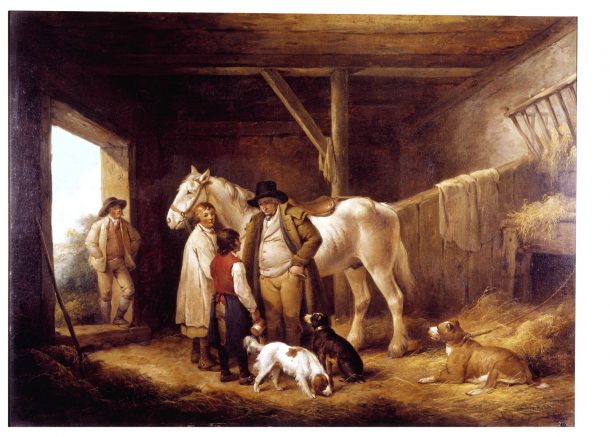Did you know that the V&A has more paintings than the National Gallery? Many are on display in galleries, but some are kept in store and at the moment are inaccessible due to a large store move project. But they are only temporarily gone, and definitely not forgotten.
One of these paintings is George Morland’s The Reckoning: the farmer paying the ostler and pot boy of an inn, painted around 1800. Paintings of rustic scenes such as this one were popular in the 18th and 19th century, however they often romanticised the beauty of the countryside for rich patrons, sanitising the harsh reality of the poverty endured by those who lived there. Such paintings can seem impenetrable to us in the 21st century due to the now unfamiliar characters and settings, and even words in the title which are seldom used anymore. However, studying such paintings can be rewarding once you unpick the who and the what in the scene and find out about the fascinating social background and relationships they highlight.
RECKONING? OSTLER? POT-BOY?
In our painting, the farmer, with his hand in his pocket, stands before two employees of an inn. He is about to settle the reckoning, which means to pay the bill, for his stay. An ostler was a man who looked after the horses of visitors to the inn, and is the figure holding the bridle of the farmer’s mount. The pot boy, seen here holding an empty tankard, performed the most menial tasks in the inn, like collecting and washing cups and plates.
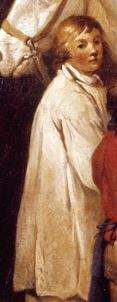
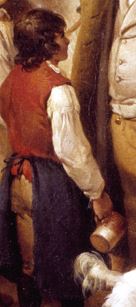
The artist of this scene, George Morland, spent much time frequenting inns, and seemed to be more comfortable surrounded by the working people in society than the rich patrons who bought his paintings. He often based his settings and characters on the poor people who passed through or worked in ale-houses like the one depicted here.
CHANGING FORTUNES OF FARMERS IN THE 18TH CENTURY
The farmer paying his bill is noticeably richer than the poor pot-boy and ostler. He is wearing finer clothes, and looks well fed. He is an example of a newly prosperous type of farmer that emerged in the 18th century.
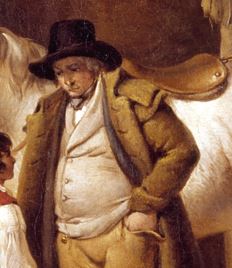
In earlier times, it was more usual that a farmer would own a small plot of land which produced enough to feed his family and maybe have a small amount of surplus to sell as a local market. In the 18th century there was an expansion in a programme of enclosure, which forcibly combined smaller sections of land into larger ones, aiming to increase agricultural output. As a result of enclosure, many farmers lost their small plots and had to find other work, but a small number were able to buy up these smaller plots to increase their land.
The new larger farms could be worked on an industrial scale, producing more yield and being more profitable. Improvements in transport by road or canal meant that surplus could be sent further afield, even to the growing cities, where more money could be made. Farmers, such as the one in our painting, could become businessmen, their standing in society rising above subsistence workers such the lowly pot boy and ostler, who existed hand to mouth on meagre wages and relying on tips from the people who used their services.
A QUESTION OF GENEROSITY?
The question the painting seems to be asking is: how fair and generous will the famer be in settling his bills? How deep is the pocket that he is dipping into? How much money will he tip those who have made his stay at the inn comfortable? The money he hands over may be what keeps these poor workers and their families from starving.
Morland himself struggled with money, was often in debt, and spent time in prison when he owed money he could not pay. It is easy to feel Moreland’s sympathy for the lowly workers. The Ostler looks out at the viewer asking us to understand his situation. The poor pot-boy looks so small and pitiable under the eyes of the farmer towering above him. Even the dogs are engaged in this question, either looking up to him in anticipation, or on the floor for any scraps. We hope, along with Moreland, that the rich farmer will be benevolent, look kindly on those of lower social standing, and redistribute his money to those beneath him.
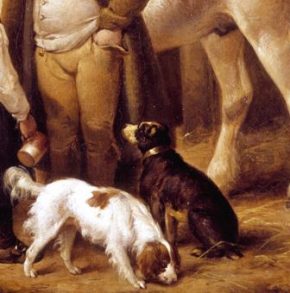
Unlike many painters of country scenes in the 19th century, Morland does not sugarcoat the characters and situations of the rural poor but showed the struggle to live that many experienced during this time. I hope that even if you did not previously know what an ostler and pot-boy were, you can now extend your sympathy to their difficult lives.
